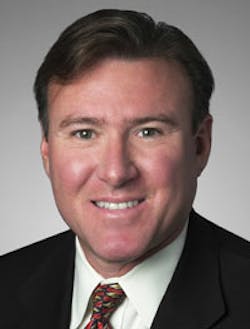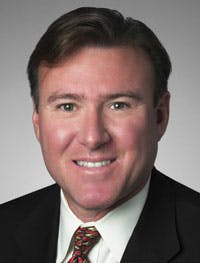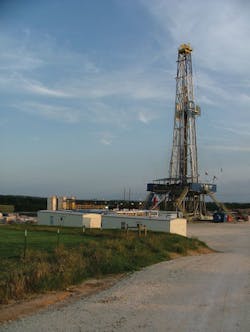Sale of Australian assets helps transform Gastar
Don Stowers, Editor, OGFJ
OIL & GAS FINANCIAL JOURNAL: About a year ago, Gastar sold its assets in Australia to Santos for about $240 million. This enabled your company to pay down debt and fund US projects. Can you talk a little about the importance of this sale and what's in store for Gastar going forward?
J. RUSSELL PORTER: We sold those assets at a price that was the equivalent of our entire enterprise value at the time. We didn't sell any proven reserves, and we didn't lose any cashflow or production. Selling that asset gave us the chance to completely redefine and reposition the company by using the proceeds to pay down all our debt, continue to expand in the Marcellus, and continue to exploit the Deep Bossier. I don't think it's an overstatement to say that, had we not done that, we probably wouldn't be here in the same way we are now.
OGFJ: What kind of assets did you have in Australia?
PORTER: We were involved in a shallow coalbed methane project.
OGFJ: How exactly did you redeploy the capital from this sale?
PORTER: The first thing we did after we paid the Australian taxes that were due was to use the proceeds almost dollar for dollar and reduced our debt to zero. We then, in November of last year, sold a high-pressure gathering system that we had constructed in East Texas and realized about a five times return on investment on that. We realized about a six times ROI on the Australian sale. So with those two actions, we had the liquidity that I think gave the market a lot of comfort. We continued to build our position in the Marcellus Shale and continued to drill the Bossier play in East Texas.
OGFJ: Which of your assets would you describe as your core area — the Bossier or the Marcellus? I know you also have some assets in the Powder River Basin.
PORTER: We do have some assets in the Power River Basin, but they're very minor. They would be a candidate for divestiture in the right market. Right now, you'd have to say that the East Texas Bossier play and, hopefully, the developing Eagle Ford play on our acreage is core. The Marcellus is just behind that based on the amount of capital spent. We'll spend more capital in East Texas this year than in the Marcellus, but next year we'll probably be close to equal capital deployed in both areas. The Marcellus has a tremendous amount of upside — 35,000 net acres we have there. We think this easily exposes us to a TCF net to the company. So I really see Gastar continuing to transform into more of a resource-oriented type company as we put more of our capital into the Marcellus, as opposed to the East Texas plays.
OGFJ: Do you have Canadian assets?
PORTER: We're a Canadian corporation by domestication, but we never had Canadian assets. We're a US-reporting company to the SEC. We do not report to the Canadian authorities. We're based in the US. All our assets are in the US. All our employees are US citizens.
OGFJ: But aren't you listed on the Toronto Stock Exchange?
PORTER: Not any more. We delisted from the Toronto exchange when we sold the assets in Australia. So we're only listed on the NYSE-AMEX Exchange.
OGFJ: Can you describe your holdings in the Bossier and Marcellus? And the second part to that question is — are your assets in predominantly dry gas areas or liquids-rich areas in each of those two plays?
PORTER: First of all, we have about 16,000 net acres in East Texas, and I mentioned that we have 35,000 in the Marcellus. In the Marcellus, we're concentrated in the northwest corner of West Virginia, in Marshall, Wetzel, and Monongalia Counties. And that is in the liquids-rich portion of the play. We also have a concentration of acreage in Butler County, Pennsylvania, and also in Clarion and Clearfield Counties. That also is a liquids-rich part of the play. We're also developing a holding in the Fayette-Somerset area of Pennsylvania, which is dry gas.
OGFJ: What about the Eagle Ford, which you mentioned earlier?
PORTER: We believe that we have some meaningful Eagle Ford potential that's on our existing acreage in Leon and Robertson counties in East Texas, where we're pursuing the Bossier play. We've seen meaningful Eagle Ford shows as we've drilled through it to these deeper Bossier wells, and there's been some recent industry activity very near us that has resulted in Eagle Ford liquids production. We're going to test the Eagle Ford potential on it with a well, probably in the next 30 to 60 days.
OGFJ: When you mention Eagle Ford, most people think of it in South Texas.
PORTER: We've seen the Eagle Ford play extending up into the area where we are in East Texas. Historically, that same stratigraphic section has been referred to as the Woodbine in East Texas.
OGFJ: How much of your current production is natural gas versus liquids?
PORTER: We're at 99% natural gas right now, but we have a goal of bringing more liquids production into our portfolio, and that's one of the reasons why we're pursuing the Eagle Ford on our Texas acreage.
OGFJ: You're not alone. With current market prices, quite a few companies are trying to change their production mix to include more liquids. Companies like Chesapeake and Petrohawk are increasingly looking to add more liquids to their production.
PORTER: We're not out trying to compete with those guys, who are paying huge dollars per acre to add liquids to their portfolios. We're really focused on exploiting what we've got now. However, we think we have a potentially impactful additional dimension to our company if we can prove up the Eagle Ford on our East Texas acreage. On our existing acreage today, we would have about 125 potential locations for Eagle Ford wells.
OGFJ: Is Gastar the operator in most of your assets?
PORTER: Yes we are.
OGFJ: Do you partner with anyone or have any joint venture agreements?
PORTER: We have a couple of private companies that are partners with us in East Texas. Our average working interest is just over 50% in the Deep Bossier play. We have been approached and have had some discussions with potential joint venture partners in the Marcellus.
OGFJ: So are you the operator in all the areas where you have assets?
PORTER: All the areas except the Powder River Basin, but that is just a minor asset for us.
OGFJ: Are you doing vertical and horizontal drilling in the Bossier and Marcellus?
PORTER: In the Bossier, it's strictly vertical because that's way too deep for any of the horizontal tools to function. We are drilling horizontal wells in East Texas to test the Eagle Ford and to test the Glen Rose limestone. And we're looking at the potential to drill horizontal wells in the Upper Bossier formation. In the Marcellus, we drilled our first vertical well in Wetzel County, West Virginia, and got very good results. It came online at 1.5 million cubic feet per day and 120 barrels of condensate a day. We will test most of our areas in the Marcellus with a vertical well, but our goal is horizontal development and we should be spudding our first operated horizontal well in the Marcellus prior to the end of this year.
OGFJ: Do you have sufficient expertise drilling horizontal wells in the Marcellus? I know you've done this in East Texas.
PORTER: Yes. The horizontal wells we've drilled in East Texas are much more complicated. They're deeper with higher temperatures and higher pressures. We've hired a general manager for our Marcellus assets who has experience in managing Appalachian drilling operations. Our drilling team and completions team here in Houston has horizontal drilling experience. The operational aspects of the physical drilling of wells in the Marcellus are pretty easy to manage. The more difficult part of that play is the permitting and the midstream infrastructure type issues.
OGFJ: Do you have projections for the next quarter?
PORTER: We don't provide a cashflow or an earnings guidance. We did project production in the 21 to 22 million cubic feet a day range on a net basis, which would be significantly higher than the second quarter due to some operational issues with a couple of our high-rate wells in East Texas, which have all been resolved. So third-quarter production will exceed second-quarter figures, and we expect the fourth quarter will be even higher.
OGFJ: It will help if commodity prices rise during the quarter.
PORTER: Well, that's why everybody is chasing oil.
OGFJ: What effect did hedging have on your bottom line and what impact will it have in the next quarter?
PORTER: Our hedging program was quite beneficial in the most recently reported quarter. It took our realized price of from about $3.50 per Mcf up to about $4.62 per Mcf. We're about 50% hedged into 2011 with positions that establish around $6 floors and some $6 - $4 shortputs. So basically, if we get down to $4, we get $6. And below $4, we get market plus $2. We've capped the price in the $7.50 to $8 range on a portion of that, and I pray every night we lose money on those. Going forward, hedging will continue to be a part of our strategy but not because of a high leverage level. Relative to other companies in our peer group, we will be under-levered. We are doing it strictly to assure that we will have a minimal level of cashflow to reinvest in these very attractive projects.
Photo courtesy of Gastar.
OGFJ: What was the reaction of the analysts to Gastar's sale of its Australian assets with your six times ROI on that and five times ROI on the sale of your East Texas gathering system?
PORTER: The reaction from the analysts and from the market was very positive. Most of the analysts agreed with our assessment that this was a transformational series of events for the company. It took us from being one of the more levered companies to one that is debt free. Honestly, I have to tell you that most of the world had probably decided that we were going to have to go through a reorganization to clean up the balance sheet, and we were able to essentially save 100% of our equity value for our equity owners, pay off all our debt, and reposition the company. So it's a turn of events that we are quite proud of.
OGFJ: That's great. So Santos turned out to be a white knight for you.
PORTER: Well, we always felt that those assets in Australia had value, and we felt the value was not reflected in our stock price. We sold that asset for a price equal to our enterprise value. So it was a just matter of having to prove the value to the world by a sale rather than having it demonstrated in our stock. Had that value been reflected in our stock, we would have gone out and sold stock and paid off the debt. We were either going to do through the equity market or through the asset market, and the asset market was much more lucrative than the equity market.
OGFJ: Thanks for taking time to talk with us, Russ.
More Oil & Gas Financial Journal Current Issue Articles
More Oil & Gas Financial Journal Archives Issue Articles
View Oil and Gas Articles on PennEnergy.com


